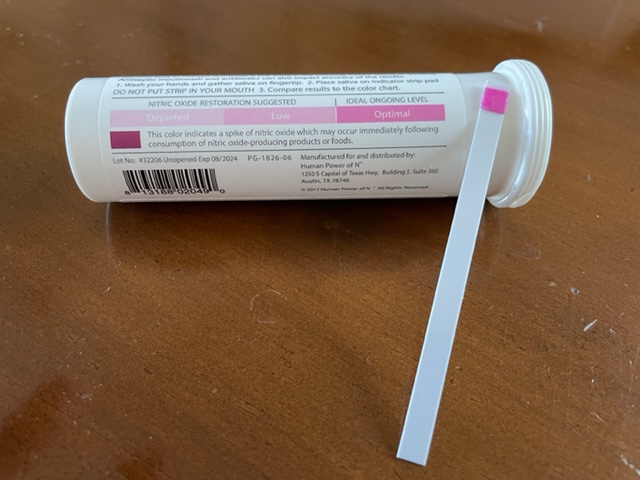
What is nitric oxide?
Nitric oxide, or ‘NO’, is a gas consisting of one molecule of nitrogen bound to one molecule of oxygen. It was called the ‘Molecule of the Year’ by Science magazine in 1992, and three pharmacologists were awarded the Nobel Prize in Medicine or Physiology in 1998.
What does it do?
NO is a ‘signaling molecule’ involved with cells in our immune function, cardiovascular system, brain, and every organ in the body. It helps regulate blood pressure, circulation, blood vessel health, and helps deliver oxygen and nutrients to every cell.
Where is it made?
The chief factory is our vascular endothelium (the innermost lining of our arteries). This lining is only one cell layer thick, but it produces the majority of our nitric oxide (NO). Nitric oxide is found abundantly but is very unstable and short-lived, so it must be continually replenished.
Can my level be tested?
Since NO is short-lived, blood is not a reliable indicator, however the stable precursor, salivary nitrate, accurately measures our NO production and tissue levels. This is performed using *HumanN® Nitric Oxide Indicator Strips, *Berkeley Life Nitric Oxide Saliva Test Strips, *Nitric Oxide Test Strips by Designs For Health, or *2 - in 1 Nitric Oxide + Oral Microbiome Test Strips, by Calroy Health Sciences (my personal favorite).
What is an optimal reading?
The majority of the first 10 readings should read ‘optimal’ on the color scale. So if 7 or more out of 10 read as optimal, then you’re good. Less means you are ‘low’ or ‘depleted’ in NO production.
Why is NO often low?
Stress, toxins, nutrient deficiency, poor diet, infections, excessive use of mouthwashes, antibiotics, regular use of antacids, blood vessel plaque, no exercise, and aging. Studies show after age 40 we produce about 50% less NO, and it gets worse every decade. NO deficiency has been shown to contribute to diabetes, cardiovascular disease, fatigue, low exercise tolerance, dementia, respiratory conditions, immune problems, brain fog, cold hands and feet, and much more.
What do I do if my tests reveal I’m low in NO?
Supplement with either *Neo40 Pro lozenges made by HumanN, *Berkeley Life Nitric Oxide Support caps, *Vascanox HP caps (my personal favorite - made by Designs for Health or Calroy Health Sciences), or *Cardio Elite liposomal liquid made by Quicksilver Scientific. Take as directed on the box or bottles. Each of these products have been shown to be effective at maintaining healthy NO levels, although clinically I've seen best results with Vascanox caps. Re-test every month or so ongoing. Studies show exercise, red beets (or organic red beet powder), celery, and dark green leafy greens help with NO levels. You may want to start with justb these options first, then re-test your NO levels after a month. However, in many cases with people over age 40 the nutritional products mentioned have shown superior results for achieving and maintaining normal levels. I recommend both the diet/exercise AND supplementation if you are age 40 or older.
***Again, you need to test your NO level. If low, you can determine what works best for you. If you do not test yourself to establish your NO levels, the diet and exercise are still helpful for general overall health but DO NOT take the above supplements. They are only recommended if your NO levels are low.
IMPORTANT NOTE: Most people over age 40 also have a damaged or defective 'glycocalyx', the microscopic gel-like layer that covers the vascular endothelium. This is a serious health risk. Similar to low N.O. levels, there can be many causes, not just age. For this, my very top recommendation is using *Arterosil caps by Designs for Health or Calroy Health Sciences. Take as directed on the bottle. *Cardio Elite by Quicksilver Scientific is another option. Both work equally well. How lucky we are to have natural, scientifically validated, side effect-free solutions to help support our blood vessels. If only our parents and previous generations knew!
*All products are available on our website pharmacy at 20% off! (HealthQuestForMe.com)
For more information, read the books: Functional Nitric Oxide Nutrition, by Nathan Bryan, PhD, and The Clot Thickens, by Malcolm Kendrick, MD.
Rev 11_7_25